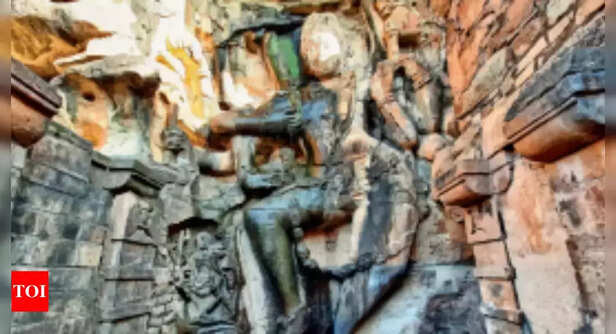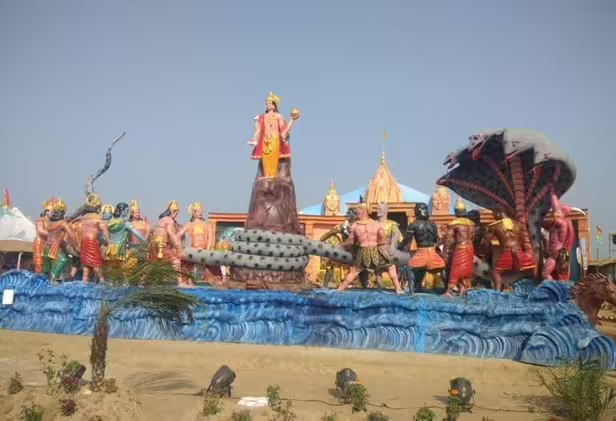Samudra Manthan: Lost History or Just a Myth?
Nidhi | Feb 25, 2025, 23:59 IST
( Image credit : Times Life Bureau )
This article delves into the profound narrative of Samudra Manthan, a pivotal event in Hindu mythology that symbolizes the eternal struggle between good and evil. It explores the collaborative endeavor of the Devas and Asuras as they churn the cosmic ocean, Kshira Sagara, using Mount Mandara and the serpent Vasuki, under the guidance of Lord Vishnu's Kurma avatar. The churning yields both the deadly poison Halahala, which Lord Shiva consumes, earning him the epithet Neelkanth, and the elixir of immortality, Amrit. This article unravels the myth’s deeper meanings, exploring its spiritual significance, symbolic lessons, and its relevance in modern life.
"Samudra Manthan ka tha samay jo aa pada,
Dwand dono lok me vishamrit pe tha chida,
Amrit sabhi main baant ke,
Pyaala vish ka tune khud piya..."
The time of Samudra Manthan had arrived—an era of turmoil where both worlds, the divine and the demonic, were entangled in an eternal battle over poison and nectar. Amrit, the elixir of immortality, was to be shared among all, but when poison emerged, one stood alone to bear the burden—Shiva, the Neelkanth, the blue-throated one.
These words from the song Namo Namo in the film Kedarnath echo an ancient tale—a story of sacrifice, cosmic balance, and the eternal struggle between creation and destruction. But was Samudra Manthan merely a mythological event, or could it be a lost chapter of forgotten history?
Let’s dive deep into this profound legend, uncovering its mystical significance and the wisdom it holds for us today.
 The great Kshira Sagara, the ocean of milk, was said to hold secrets beyond imagination. The Devas (celestial beings) and Asuras (demons), sworn enemies, struck an uneasy alliance. The goal? To churn the ocean and retrieve Amrit, the nectar of immortality.
The great Kshira Sagara, the ocean of milk, was said to hold secrets beyond imagination. The Devas (celestial beings) and Asuras (demons), sworn enemies, struck an uneasy alliance. The goal? To churn the ocean and retrieve Amrit, the nectar of immortality.
Their tool? Mount Mandara, which became the churning rod.
Their rope? Vasuki, the king of serpents, wrapped around the mountain.
Their anchor? Lord Vishnu, who took the form of Kurma, the divine turtle, to support the weight of it all.
The churning began, and from the depths of the ocean surfaced divine treasures—Goddess Lakshmi, the Moon, Kamadhenu (the wish-fulfilling cow), Kalpavriksha (the celestial tree), and even celestial apsaras (divine dancers).
But before Amrit could emerge, the ocean spewed forth Halahala—a poison so deadly that it could annihilate all creation. Neither gods nor demons could contain it.
 "Amrit sabhi main baant ke,
"Amrit sabhi main baant ke,
Pyaala vish ka tune khud piya..."
As chaos unfolded, Shiva, the Supreme Yogi, stepped forward. Without hesitation, he cupped the venom in his hands and drank it whole. The universe held its breath.
The poison did not kill him, but it turned his throat deep blue, earning him the name Neelkanth—the one with a blue throat.
This was a defining moment in the cosmic battle. Shiva’s selflessness saved the world, teaching us that true power lies not in seeking nectar, but in having the courage to swallow the poison when no one else will.
Could Samudra Manthan have been an allegory for something deeper? Several interpretations exist:

Life is a constant Samudra Manthan—an unending churn between hardships and blessings. When facing your own Halahala, remember: 
"Dwand dono lok me vishamrit pe tha chida..."
Even today, the world mirrors this cosmic battle. Every soul, every heart, faces its own churning of emotions, conflicts, and choices.
But the story of Samudra Manthan is not about destruction—it is about transcendence.
So the next time life tests you, ask yourself: Will you run from it, or will you be the Neelkanth who transforms it?
Because in the end, the churning always leads to nectar.
"Namo Namo Ji Shankara, Bholenath Shankara..."
May Shiva’s wisdom guide you through your own Manthan.
Dwand dono lok me vishamrit pe tha chida,
Amrit sabhi main baant ke,
Pyaala vish ka tune khud piya..."
The time of Samudra Manthan had arrived—an era of turmoil where both worlds, the divine and the demonic, were entangled in an eternal battle over poison and nectar. Amrit, the elixir of immortality, was to be shared among all, but when poison emerged, one stood alone to bear the burden—Shiva, the Neelkanth, the blue-throated one.
These words from the song Namo Namo in the film Kedarnath echo an ancient tale—a story of sacrifice, cosmic balance, and the eternal struggle between creation and destruction. But was Samudra Manthan merely a mythological event, or could it be a lost chapter of forgotten history?
Let’s dive deep into this profound legend, uncovering its mystical significance and the wisdom it holds for us today.
The Cosmic Churning: When the Ocean Held Secrets

Samudra Manthan
( Image credit : Times Life Bureau )
Their tool? Mount Mandara, which became the churning rod.
Their rope? Vasuki, the king of serpents, wrapped around the mountain.
Their anchor? Lord Vishnu, who took the form of Kurma, the divine turtle, to support the weight of it all.
The churning began, and from the depths of the ocean surfaced divine treasures—Goddess Lakshmi, the Moon, Kamadhenu (the wish-fulfilling cow), Kalpavriksha (the celestial tree), and even celestial apsaras (divine dancers).
But before Amrit could emerge, the ocean spewed forth Halahala—a poison so deadly that it could annihilate all creation. Neither gods nor demons could contain it.
Neelkanth: The One Who Drank the Poison

Kedarnath
( Image credit : Times Life Bureau )
Pyaala vish ka tune khud piya..."
As chaos unfolded, Shiva, the Supreme Yogi, stepped forward. Without hesitation, he cupped the venom in his hands and drank it whole. The universe held its breath.
The poison did not kill him, but it turned his throat deep blue, earning him the name Neelkanth—the one with a blue throat.
This was a defining moment in the cosmic battle. Shiva’s selflessness saved the world, teaching us that true power lies not in seeking nectar, but in having the courage to swallow the poison when no one else will.
Myth or Forgotten History?
Could Samudra Manthan have been an allegory for something deeper? Several interpretations exist:

Shiva: Kalinjar
( Image credit : Times Life Bureau )
- Astronomical Theory: Some believe it represents planetary movements—a cosmic dance of destruction and creation.
- Scientific Perspective: Others see it as an ancient chemical process, symbolizing purification through churning.
- Spiritual Meaning: The most profound explanation sees Samudra Manthan as an internal journey—the struggle within every soul, where darkness and light collide before enlightenment emerges.
Lessons from the Churning of Life

Samudra Manthan
( Image credit : Times Life Bureau )
- Endurance: Like Mount Mandara, stay firm amidst chaos.
- Transformation: Like Shiva, embrace suffering and turn it into strength.
- Patience: Like the gods and demons, trust that Amrit comes after the struggle.
The Churning Never Ends…
Even today, the world mirrors this cosmic battle. Every soul, every heart, faces its own churning of emotions, conflicts, and choices.
But the story of Samudra Manthan is not about destruction—it is about transcendence.
So the next time life tests you, ask yourself: Will you run from it, or will you be the Neelkanth who transforms it?
Because in the end, the churning always leads to nectar.
"Namo Namo Ji Shankara, Bholenath Shankara..."
May Shiva’s wisdom guide you through your own Manthan.
